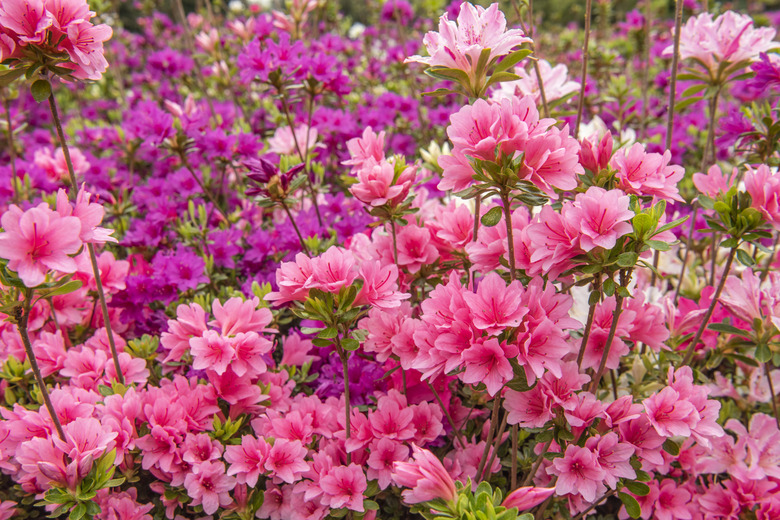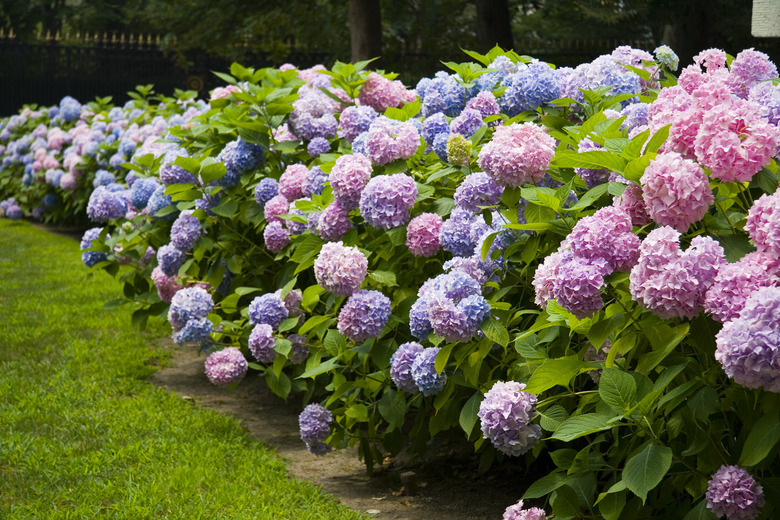The 11 Best Flowers To Plant In Morning Sun And Afternoon Shade
Sunshine helps plants generate energy, but more isn't always better. While some succulents and cacti revel in direct afternoon sun in some climates, many garden shrubs and flowers prefer some shade in a hot-summer climate.
Want to know what the best flowers to plant in morning sun and afternoon shade are? Here are 12 of our picks.
1. Impatiens (Impatiens walleriana)
Common impatiens are perennial flowers only in zones 10 and 11, but elsewhere they're typically grown as annuals — plants that live in the moment, giving their all for the one season they live. They germinate, seed, and die in one year, but they often reseed the flower bed so you see more of them the following year.
With light- to dark-green leaves and flowers in a wide variety of colors, impatiens are a top bedding plant in the United States. They grow 6 to 24 inches tall.
2. Lobelia (Lobelia erinus)
Lobelia is another popular flowering plant. Although it's a tender perennial in zones 10 and 11, it's typically grown as an annual garden plant elsewhere. It likes afternoon shade rather than direct sunlight during this part of the day. It is a compact plant, growing under 1 foot tall, and may take either an upright or trailing form. The trailing forms with white, scarlet, or blue tubular flowers, each with two lips, are perfect for planting in hanging baskets or planters or as ground cover.
3. Flowering tobacco (Nicotiana spp.)
While the common name as well as the genus name may bring tobacco to mind, flowering tobacco is a tender perennial in the nightshade family. Its more attractive species are grown as garden ornamentals for their bright annual flowers, not to use in cigarettes.
The tall stems of plants like Nicotiana sylvestris decorate the garden with large, dramatic leaves and showy, fragrant clusters of drooping white flowers that look like a burst of fireworks. While flowering tobacco classifies as a perennial, it is a tender perennial that lives for more than one winter only in USDA hardiness zones 10 and 11, but it develops quickly and can be grown easily as an annual.
4. Clematis (Clematis spp.)
Perennials are plants that live and blossom for more than one season, sometimes for many years. They are foundation plants in a garden. Try clematis, a gorgeous perennial flowering vine that climbs 6 to 18 feet provided a trellis or fence is used as support. It's hardy to U.S. Department of Agriculture plant hardiness zone 3 and likes morning sun with afternoon shade.
5. Yesterday-today-and-tomorrow plant (Brunfelsia pauciflora)
Here's a perennial evergreen shrub in the nightshade family with an interesting name. The yesterday-today-and-tomorrow plant gets its common name from the changing hues of its blooms that go from deep purple to lavender to white as they mature. It also offers leathery leaves and grows from 3 to 5 feet tall and 2 to 4 feet wide. Plant it outside as a perennial in the warm climates of USDA zones 9 to 11 and as an annual in cooler areas.
6. Golden corydalis (Corydalis lutea)
Golden corydalis is a woodland perennial with mounding, ferny green foliage to 15 inches tall and 18 inches wide. It offers racemes of bright yellow, short-spurred flowers over a long-blooming season that starts in May and lasts through early fall (September). Golden corydalis works beautifully on a slope that gets shade in the afternoon. Its bright leaves form a ferny mound, and the canary-yellow flowers bloom month after month. It needs virtually no maintenance at all in USDA zones 5 to 7.
7. Bigleaf hydrangea (Hydrangea macrophylla)
Perennial shrubs make bigger statements in the garden than regular flowering plants. Bigleaf hydrangeas are popular shrubs with flowers that change color. They can produce blue flowers, pink flowers, or even purple flowers according to the acidity or alkalinity of the soil. Gardeners love to amend the soil and watch the transformation.
These easy-care shrubs bloom best when planted on a site with full shade or partial shade in the afternoons. Too much sun dries out the leaves and fades the brilliant jewel colors of the blossoms. Pick either hortensias, those mophead-style flowers, or lacecaps, flat-top flowers with fertile, nonshowy flowers in the center and more showy sterile flowers on the outside.
8. American snowbell (Styrax americanus)
Also called America silverbell, this tall, native shrub is an easy-care perennial, covered with white bell-shaped blossoms in spring. American snowbell is not a perennial that prefers full sun. Although it will grow fairly well in full sun in some climates, it will need more water in these locations. Rather, plant it in partial shade on well-drained soil. A few hours of rays in the morning are enough to allow it to flower.
9. Azaleas and rhododendrons (Rhododendron spp.)
These closely related species are known as the queens of the shade garden, but in fact, most of these flowering shrubs prefer morning sun and afternoon shade. Still, some species will bloom in full shade, and all offer colorful flowers in springtime. Some types are remontant, or reblooming, plants that offer the traditional spring flowers, with a second round of flowers appearing in late summer to fall. Their large, frilly blossoms can be incredibly beautiful and fragrant.
10. Begonias (Begonia spp.)
Begonias come in over 1,300 different species and cultivars, so a gardener should have no trouble finding something that will work well in their space. These are commonly used bedding plants grown for their flowers, and some also have exotic foliage. Popular types include wax begonias, cane or angel-wing begonias, and rhizomatous begonias. They can provide dramatic color in the garden all year long. Most are perennials but are often grown as annuals in warmer regions. You can find them for sale as potted plants.
With a notable exception, begonias grow and flower best when they receive some morning sun but afternoon shade. The exception is wax begonia (Semperflorens-Cultorum Group), which may have solid-green leaves or bronze leaves. The bronze-leaf types grow and flower best in full sun, but the green-leaf types need part shade.
11. Coral Bells (Heuchera spp.)
Pick one of the native species of coral bells or one of the many cultivars for truly low-maintenance flowering plants. These perennials make an excellent addition to partly shady landscape plantings, with many foliage tones available in commerce. Coral bells are popular with gardeners for their unusual green heart-shaped or roundish leaves as well as their upright panicles of tiny white, bright pink or red bloomers. The leaves can be lightly colored, a deep shade or exotically variegated, with many options available. They bloom in late spring, and the flowers last through early summer.
